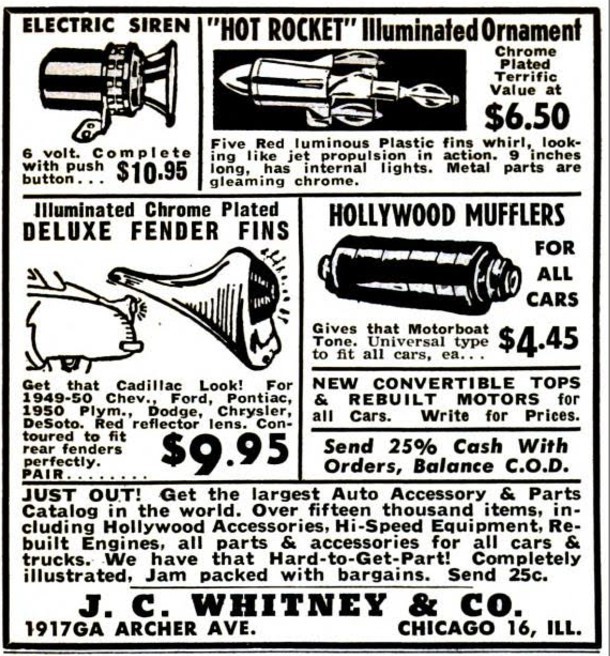For generations of car enthusiasts and DIY mechanics, the name J C Whitney has been synonymous with automotive parts and accessories. From humble beginnings as a Chicago scrap metal yard, J C Whitney grew into a mail-order giant, becoming a cultural icon for those looking to maintain, repair, and customize their vehicles. This article delves into the rich history of J C Whitney, tracing its evolution and exploring its enduring impact on the automotive aftermarket, particularly in the realm of J C Whitney Car Parts.
The Humble Origins of an Auto Parts Empire
The story of J C Whitney begins with Israel Warshawsky, a Lithuanian immigrant who arrived in Chicago seeking refuge from religious persecution. In the early 20th century, he established a scrap metal yard on Chicago’s south side. While this venture provided a modest living, the real transformation began when his son, Roy Warshawsky, joined the business in 1934. Roy, inspired by the success of mail-order pioneers like Sears and Roebuck, envisioned expanding beyond Chicago by entering the burgeoning mail-order catalog industry. To broaden its appeal, the company adopted the less ethnic-sounding name J C Whitney.
Vintage JC Whitney catalog cover from July 1950 showcasing early car parts and accessories.
Initially, Roy promoted the business through classified ads in magazines like Popular Science and Popular Mechanics. These early advertisements laid the groundwork for what would become a mail-order empire, offering j c whitney car parts and accessories to a wider audience.
The Catalog Era: J C Whitney Becomes a Household Name for Car Parts
The 1950s marked the true ascent of J C Whitney. The small classified ads evolved into full-page spreads, and the iconic J C Whitney catalog became a fixture in workshops and garages across America. Printed on pulp paper with dense pages of tiny print and minimalist line drawings, the catalog was a unique window into the automotive trends of the era. It offered a vast selection of j c whitney car parts, from essential maintenance components to an array of unique accessories.
1954 Popular Mechanics magazine ad for JC Whitney car parts and accessories.
During this period, J C Whitney still focused on “hard parts”—replacement components such as alternators, brakes, body panels, and even complete engines. These j c whitney car parts, while essential for vehicle maintenance, were often heavy and costly to ship, resulting in lower profit margins.
An old JC Whitney catalog page featuring hard car parts and engine components.
However, it was the extensive and often outlandish accessories that truly cemented J C Whitney’s fame. These accessories, unlike hard parts, were inexpensive to manufacture, purchase, and ship, often yielding significant profit margins. This shift towards accessories defined the J C Whitney brand for many.
Accessories and the Allure of Automotive Gimmicks
J C Whitney’s catalog became renowned for its quirky and sometimes questionable accessories. From paint designed to create the illusion of whitewall tires to add-on features mimicking luxury car styling, the catalog offered a dream: the ability for anyone to customize and upgrade their vehicle, regardless of budget.
JC Whitney catalog ad showing various car accessories and styling upgrades.
Whether these “gimmicks” truly delivered on their promises was often secondary to the appeal of automotive personalization. J C Whitney tapped into the desire for car owners to express their individuality and keep their vehicles looking modern, even as models aged. Products like kits to add quad headlights to older cars, mimicking the 1958 styling trend, or aftermarket third brake lights for pre-1986 vehicles, catered to this desire for automotive upgrades and customization.
Humorous JC Whitney ad for whitewall tire paint and car styling accessories.
This eclectic product mix allowed J C Whitney to appeal to a diverse range of automotive enthusiasts:
- The Budget-Conscious: Those needing affordable j c whitney car parts to keep older vehicles running. Items like hand starters for Volkswagen Beetles catered to this market.
- The Style-Seekers: Individuals wanting to enhance their car’s appearance with styling cues from more expensive models through aftermarket accessories.
- The Customizers: Car owners looking to personalize their vehicles and express their unique style with a variety of add-ons and accessories.
JC Whitney ad selling dual headlight kits to upgrade older cars.
J C Whitney created a space where everyone was welcome, regardless of income or vehicle type. The brand democratized car customization and repair, making j c whitney car parts and accessories accessible to a broad spectrum of car owners.
Headwinds and Shifting Gears: The Decline of the Catalog Giant
By the 1970s, the automotive landscape began to change. Rising fuel prices, increasingly complex vehicle electronics, and new emissions control regulations made DIY car repair more challenging for the average owner. This shift impacted J C Whitney’s core business. Despite its iconic status, the company filed for Chapter XI bankruptcy in 1979, a fact largely unknown even to its employees. While they successfully reorganized, this marked the beginning of a period of challenges.
Unusual JC Whitney product – a pull starter for Volkswagen cars.
In the 1980s and 1990s, the catalog’s focus shifted further away from lower-margin “hard parts” and increasingly towards cheaper, often low-quality accessories manufactured in China. While the catalog retained its signature tiny print and line art, the product quality declined, and many offerings became less practical.
JC Whitney magazine ad from October 1952 promoting a range of auto accessories.
Roy Warshawsky retired in 1991, and after his passing in 1997, the company was sold in 2002 to The Riverside Company, a private equity firm. J C Whitney was no longer a family-owned business. Despite efforts to revitalize the brand in the 2000s, including acquisitions and a move to a more modern corporate setting, the core J C Whitney business continued to struggle.
The Digital Age and the End of an Era for J C Whitney Car Parts
The rise of e-commerce and online auto parts retailers presented a significant challenge. J C Whitney faced competition from nimble online storefronts with lower overhead and aggressive pricing. Attempts to adapt, such as the creation of carparts.com as a no-frills online competitor, proved insufficient to reverse the decline.
JC Whitney magazine advertisement from May 1992 featuring car accessories.
The 2008 financial crisis further exacerbated the situation. Efforts to reposition J C Whitney as a more upscale brand clashed with the economic downturn, where consumers were increasingly seeking value and affordability. The brand, once synonymous with inexpensive j c whitney car parts and accessories, struggled to resonate with a new generation of car owners who turned to online marketplaces like eBay and Amazon.
Ovaltine drink mix, representing aging brands like JC Whitney in the changing market.
In 2010, J C Whitney was acquired by US Auto Parts (now CarParts.com). The acquisition marked the end of J C Whitney as an independent entity. While the name persists as a storefront for CarParts.com, the original Chicago-based company and its iconic catalog are relics of the past. The print catalog, once a cornerstone of the business, is largely discontinued, with only specialty catalogs for Jeep and Truck parts remaining for a time.
J C Whitney’s Enduring Legacy
Today, while jcwhitney.com redirects to carparts.com and the print catalogs are largely gone, the name J C Whitney still evokes a sense of nostalgia for many car enthusiasts. It represents a time when automotive customization and repair were more accessible to the average person. The legacy of J C Whitney lies in its pioneering role in the mail-order auto parts industry and its impact on American car culture. Though the company’s trajectory took a different turn in the digital age, its contribution to making j c whitney car parts and accessories readily available to generations of drivers remains a significant chapter in automotive history.
References:
https://www.hemmings.com/magazine/hcc/2006/10/Roy-Warshawsky/1351501.html
http://multichannelmerchant.com/news/j-c-whitney-sold-01082002/

